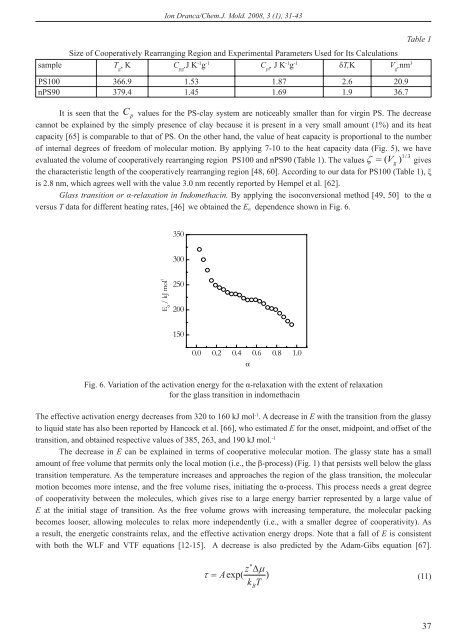chemistry journal of moldova
chemistry journal of moldova
chemistry journal of moldova
You also want an ePaper? Increase the reach of your titles
YUMPU automatically turns print PDFs into web optimized ePapers that Google loves.
Ion Dranca/Chem.J. Mold. 2008, 3 (1), 31-43Table 1Size <strong>of</strong> Cooperatively Rearranging Region and Experimental Parameters Used for Its Calculationssample T g, K C pg,J K -1 g -1 C pl, J K -1 g -1 T,K V g,nm 3PS100 366.9 1.53 1.87 2.6 20.9nPS90 379.4 1.45 1.69 1.9 36.7It is seen that the Cp values for the PS-clay system are noticeably smaller than for virgin PS. The decreasecannot be explained by the simply presence <strong>of</strong> clay because it is present in a very small amount (1%) and its heatcapacity [65] is comparable to that <strong>of</strong> PS. On the other hand, the value <strong>of</strong> heat capacity is proportional to the number<strong>of</strong> internal degrees <strong>of</strong> freedom <strong>of</strong> molecular motion. By applying 7-10 to the heat capacity data (Fig. 5), we have1/3evaluated the volume <strong>of</strong> cooperatively rearranging region PS100 and nPS90 (Table 1). The values ( V g) givesthe characteristic length <strong>of</strong> the cooperatively rearranging region [48, 60]. According to our data for PS100 (Table 1), is 2.8 nm, which agrees well with the value 3.0 nm recently reported by Hempel et al. [62].Glass transition or -relaxation in Indomethacin. By applying the isoconversional method [49, 50] to the versus T data for different heating rates, [46] we obtained the E dependence shown in Fig. 6.350300E / kJ mol -12502001500.0 0.2 0.4 0.6 0.8 1.0Fig. 6. Variation <strong>of</strong> the activation energy for the -relaxation with the extent <strong>of</strong> relaxationfor the glass transition in indomethacinThe effective activation energy decreases from 320 to 160 kJ mol -1 . A decrease in E with the transition from the glassyto liquid state has also been reported by Hancock et al. [66], who estimated E for the onset, midpoint, and <strong>of</strong>fset <strong>of</strong> thetransition, and obtained respective values <strong>of</strong> 385, 263, and 190 kJ mol. -1The decrease in E can be explained in terms <strong>of</strong> cooperative molecular motion. The glassy state has a smallamount <strong>of</strong> free volume that permits only the local motion (i.e., the -process) (Fig. 1) that persists well below the glasstransition temperature. As the temperature increases and approaches the region <strong>of</strong> the glass transition, the molecularmotion becomes more intense, and the free volume rises, initiating the -process. This process needs a great degree<strong>of</strong> cooperativity between the molecules, which gives rise to a large energy barrier represented by a large value <strong>of</strong>E at the initial stage <strong>of</strong> transition. As the free volume grows with increasing temperature, the molecular packingbecomes looser, allowing molecules to relax more independently (i.e., with a smaller degree <strong>of</strong> cooperativity). Asa result, the energetic constraints relax, and the effective activation energy drops. Note that a fall <strong>of</strong> E is consistentwith both the WLF and VTF equations [12-15]. A decrease is also predicted by the Adam-Gibs equation [67].z Aexp()k TB(11)37
















